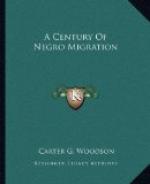Later we receive another interesting account of this exodus. David White led a company of fifty-three into the West, thirty-eight of whom belonged to Friends, five to a member who had ordered that they be taken West at his expense. Six of these slaves belonged to Samuel Lawrence, a Negro slaveholder, who had purchased himself and family. White pathetically reports the case of four of the women who had married slave husbands and had twenty children for the possession of whom the Friends had to stand a lawsuit in the courts. The women had decided to leave their husbands behind but the thought of separation so tormented them that they made an effort to secure their liberty. Upon appealing to their masters for terms the owners, somewhat moved by compassion, sold them for one half of their value. White then went West and left four in Chillicothe, twenty-three in Leesburg and twenty-six in Wayne County, Indiana, without encountering any material difficulty.[12]
Others had thought of this plan but the Quakers actually carried it out on a small scale. Here we see again not only their desire to have the Negroes emancipated but the vital interest of the Quakers in success of the blacks, for members of this sect not only liberated their slaves but sold out their own holdings in the South and moved with these freedmen into the North. Quakers who then lived in free States offered fugitives material assistance by open and clandestine methods.[13] The most prominent leader developed by the movement was Levi Coffin, whose daring deeds in behalf of the fugitives made him the reputed President of the Underground Railroad. Most of the Quaker settlements of Negroes with which he was connected were made in what is now Hamilton, Howard, Wayne, Randolph, Vigo, Gibson, Grant, Rush, and Tipton Counties, Indiana, and Darke County, Ohio.
The promotion of this movement by the Quakers was well on its way by 1815 and was not materially checked until the fifties when the operations of the drastic fugitive slave law interfered, and even then the movement had gained such momentum and the execution of that mischievous measure had produced in the North so much reaction like that expressed in the personal liberty laws, that it could not be stopped. The Negroes found homes in Western New York, Western Pennsylvania and throughout the Northwest Territory. The Negro population of York, Harrisburg and Philadelphia rapidly increased. A settlement of Negroes developed at Sandy Lake in Northwestern Pennsylvania[14] and there was another near Berlin Cross Roads in Ohio.[15] A group of Negroes migrating to this same State found homes in the Van Buren Township of Shelby County.[16] A more significant settlement in the State was made by Samuel Gist, an Englishman possessing extensive plantations in Hanover, Amherst, and Henrico Counties, Virginia. He provided in his will that his slaves should be freed and sent to the North. He further provided that the revenue from his plantation the last year of his life be applied in building schoolhouses and churches for their accommodation, and “that all money coming to him in Virginia be set aside for the employment of ministers and teachers to instruct them.” In 1818, Wickham, the executor of his estate, purchased land and established these Negroes in what was called the Upper and Lower Camps of Brown County.[17]




